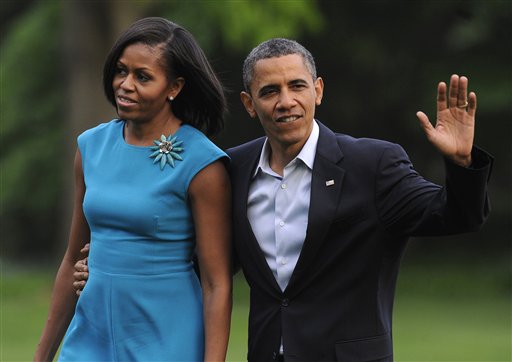(AP) Twitter plays outsize role in 2012 campaign
By BETH FOUHY
Associated Press
NEW YORK
(at)BarackObama is on Twitter. So is (at)MittRomney. And so are all the voters following the 2012 presidential contest, whether they know it or not.
Candidates, strategists, journalists and political junkies have all flocked to Twitter, the social networking hub where information from the mundane to the momentous is shared through 140-character microbursts known as tweets.
While relatively few voters are on Twitter _ a study by the Pew Research Center found that about 13 percent of American adults have joined the site _ it’s become an essential tool for campaigns to test-drive themes and make news with a group of politically wired “influencers” who process and share those messages with the broader world.
Put simply: When a voter is exposed to any information related to the presidential contest, chances are it’s been through the Twitter filter first.
No one believes the campaign will be won or lost on Twitter _ it’s just one slice of an enormous communication effort the presidential campaigns are waging in cyberspace. But with a well-timed 140-character blast, candidates influence coverage, respond to charges or reinforce talking points.
This, of course, is not the first time technology has changed the way campaigns are conducted. Radio, TV and the Internet all prompted campaigns to adapt, giving both more avenues to reach voters and more control of their message. But radio and television are top-down mediums at heart _ from the broadcaster to the public. Never before has a grassroots technology like Twitter given both voice and power to millions _ and given candidates a real-time way to monitor the effects of their messages and recalibrate on the fly.
And that means an ever-changing campaign narrative for 2012.
Four years ago, Twitter was still in relative infancy and just 1.8 million tweets were sent on Election Day 2008. Now, Twitter gets that many approximately every eight minutes.
Obama’s 2012 State of the Union address drew 800,000 tweets, Twitter said. And tweets mentioning Rick Santorum jumped from 10-20 per minute to over 2,500 tweets per minute when news broke that he was suspending his bid for the Republican presidential nomination.
Both the Obama and Romney campaigns have actively embraced Twitter, using it to communicate directly with supporters and, more importantly, drive the political conversation in a way that reaches far beyond the site. They’re also mindful of the hazards of Twitter, designating war room staffers to monitor the site for problems to address or gaffes from their rivals to exploit.
Twitter’s impact was on vivid display last week.
Obama, warning a college audience that interest rates on their federal student loans could double if Congress doesn’t act soon, urged students to make their voices heard on Twitter.
The Obama campaign’s introduction of a campaign tool named Julia also showcased what both parties will do to get the last word on Twitter.
The Obama team unveiled an interactive slideshow on its website showing how a hypothetical woman named Julia whom the campaign says would benefit from the president’s policies throughout her life.
Republicans, for their part, moved quickly on Twitter to respond _ tying Julia to the persistent weak economy.
Twitter’s warp speed presents both an opportunity and a challenge to campaigns ever vigilant about maintaining message discipline.
The Romney campaign sought to seize advantage after Democratic strategist Hilary Rosen remarked that the presumptive Republican presidential nominee’s wife, Ann, a stay at home mother of 5 sons, had “never worked a day in her life.” Polls show Romney lagging badly among women voters, and his advisers have sought ways to mitigate the gender gap.
After Rosen’s comments on CNN quickly exploded _ on Twitter _ the Romney campaign launched a Twitter feed from the candidate’s wife.
Ann Romney’s engagement on Twitter quickly earned her several thousand followers on the site. But it also scored news headlines and helped cast Democrats as unsympathetic to women who stay home with children _ a score for the Romney campaign that went far beyond the Twitter audience.
Twitter has also caused both campaigns plenty of headaches.
The Obama team was forced onto defense during the Rosen controversy, even though she has no connection to the president’s re-election effort. The campaign deployed Michelle Obama to push back on Rosen.
In February, Romney delivered an economic speech at Ford Field in Detroit _ a must-win primary state for the Michigan native as he battled rival Santorum for the GOP nomination.
But hours earlier, reporters began tweeting photos of the nearly empty football arena and the small section of it reserved for Romney’s event. By the time the former Massachusetts governor delivered the address, the ill-chosen venue had become the story instead.
Twitter helped lead to the resignation of a Romney foreign policy spokesman this week. Richard Grenell stepped down from his post in part because of caustic tweets he had sent about a host of public figures including Rachel Maddow and Newt and Callista Gingrich.
Indeed, Tom Rosenstiel, director of the Pew Research Center’s Project for Excellence in Journalism, said the snark factor is one of Twitter’s biggest pitfalls.
But, he added, “Twitter has this quality of being an alert system that elevates it above the number of people using it.”
___
Follow Beth Fouhy on Twitter at http://www.twitter.com/bfouhy

COMMENTS
Please let us know if you're having issues with commenting.